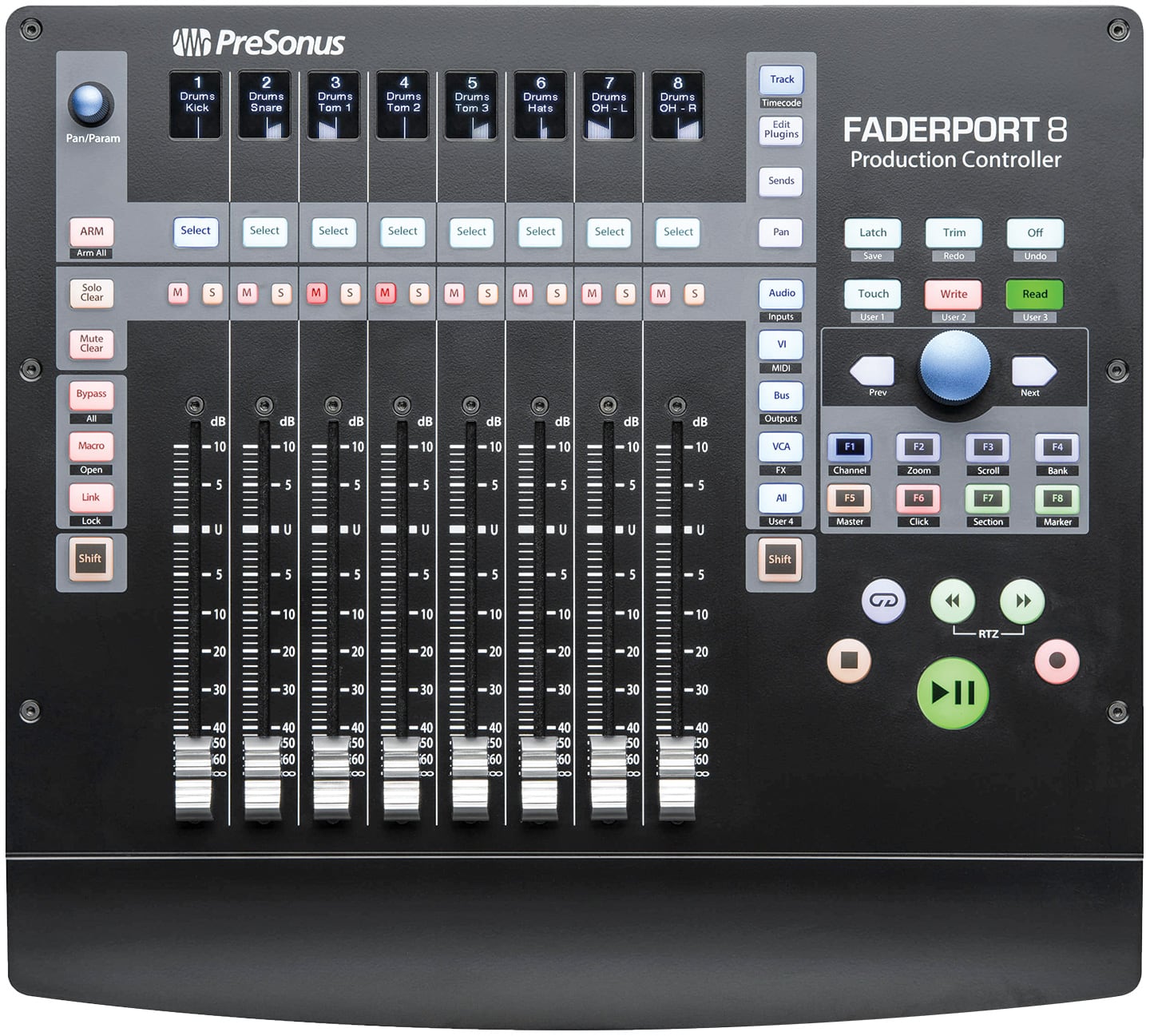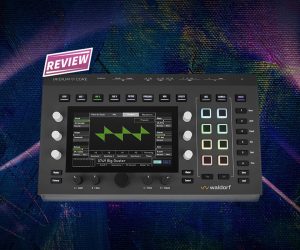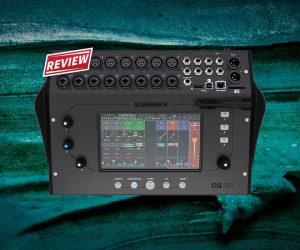
Review: Presonus Faderport 8
Presonus builds on the success of FaderPort, but is the FaderPort 8 really eight times better than its single-fadered sibling?
Okay, so I have a thing for faders. Real faders, by the way — not those plasticky, Fisher Price, non-motorised types. But to my shame I’ve been mixing without them for a fair while now, with no better excuse than insufficient desk real estate. I even settled into performing automation moves with a mouse (gasp!).
Thankfully the FaderPort 8 landed on my desk for review. Oh, happiness! Eight glorious, touch-sensitive, motorised faders surrounded with digital backlit scribble strips, extensive transport controls, a preposterous number of buttons, and a very modest asking price. It was like falling in love all over again — with mixing, that is.
SAFE IN PORT
Presonus’s original FaderPort brought the envied motorised fader to bedroom studios around the world in a cheap and compact single-fader unit. Similar controllers were available from other vendors but the FaderPort dwarfed them in popularity.
With Studio One becoming a big player in the DAW game and the company steadily building its own ecosystem of interconnectable devices with the StudioLive family, it made sense for Presonus to create a more thorough iteration of the FaderPort. The CS18AI finally brought motorised faders to the StudioLive paradigm, but that’s also why it can’t really be reduced to competing as a simple DAW controller.
Enter FaderPort 8. Pitched as the ultimate Studio One controller, it fills a niche that extends Presonus’s vision of being an in-house stable of hardware and software products that’ll do it all. Kinda like a budget-friendly version of Avid, five years ago.
The FaderPort 8 is a class compliant device, so no driver installation is necessary to get it running with your computer. Spaciously laid out controls give the surface a professional feel. I love the extra room underneath the faders to rest the heel of your hand. Onto the niggles: the surface kicks back at a slight angle but it’s still just shy of having the scribble strips at the best viewing angle, the diminutive Solo and Mute buttons are a slight design flaw — they’re so close together that you can easily press both with one finger, and the ‘lump in the lead’ external power supply always feels a bit budget.
ONE TO EIGHT
FaderPort 8 has a few carryover features from the original FaderPort. Obviously the fader itself has been copied and pasted seven times, and each one oozes ‘pro’. They’re smooth and pleasantly-weighted, with quick and quiet motors, ergonomic finger curvatures, and a generous 100mm of travel.
The pan pot has been (excuse the pun) ported as well, though unfortunately this didn’t propagate an extra seven. Yep, you only get one endless pan/parameter knob that lives on the top left of the surface. Selecting a track before panning it isn’t an enormous inconvenience, but I reckon it’s just enough to get on your nerves when trying to throw together a mix quickly. The detents aren’t my favourite either, but it does help when scrolling through menus.
So what’s changed? The buttons, for one. The original FaderPort had plastic buttons that clicked noisily when pressed. FaderPort 8 sports silent rubber buttons that still feel good to push. The only things that’ll go clickety-clack are the pan/transport knobs and the faders when they hit minus infinity.
NEED TO KNOW
Presonus Faderport 8
Control Surface

JOG AROUND THE BLOCK
Presonus doesn’t call the FaderPort 8’s large blue knob a jog wheel, but given you can scrub through your session with it you’d be forgiven for such an assumption. It’s small, firmly detented, and doubles as a push button, but unfortunately fails as a jog wheel. I would’ve loved to see this twice its diameter, half its height, smoothly weighted without detents, and with a little crater on top for single-finger operation; like every other professional control surface. If this was the case you could easily and accurately control timeline position with just your right hand — forefinger on the jog wheel, thumb on Play/Pause — leaving your left hand for individual track controls. In the knob’s defence, it’s an excellent multi-tasker thanks to the eight buttons below that dictate its function.
DOING THE HUI DANCE
Pro Tools is my home DAW, so if the FaderPort 8 didn’t do HUI well, I probably wouldn’t be writing this review. Thankfully it handles it nicely for the most part. Boot into HUI mode by holding the first two Select buttons while powering the unit on, choose HUI, and press Exit. MCU (Mackie Control Universal) mode is also available for Logic, Cubase, Ableton and Sonar. FaderPort 8 remembers what you’ve last selected until you change it again.
All the usual functions were perfectly fine in HUI mode — levels, solos, mute, pans, transport, automation, markers, etc. But it bared its soft underbelly soon enough. Controlling plug-ins in Pro Tools was nothing short of a nightmare. It felt like digging several layers deep into menus with no clear escape route, all while squinting at abbreviated scribble strip readouts hoping you’re adjusting what you hope you’re adjusting. To get the most out of it you’d have to spend some hours repurposing the Studio One-specific buttons into user-defined hotkeys that’ll suit your workflow. Or if you’re a ’Tools person, buy a EUCON-equipped surface like the Avid Artist Mix and be done with it.

OPERATION AUTOMATION
As with its predecessor, writing automation is the FaderPort 8’s forte. It’s the one thing anyone could do without reading the manual or glancing at the computer screen. The six dedicated automation mode buttons above the jog wheel affect the selected track in your DAW, and the controls translate across whichever mode the control surface is operating in, be it HUI, MCU or Native.
I’m a big fan of Touch mode. I often treat a track with a single rough pass of level automation, then go back and overwrite micro-improvements in real-time. On some control surfaces, grabbing a fader while it’s following written automation can feel sticky or resistant. Not so with FaderPort 8. It seamlessly begins writing your new moves from the moment you touch a fader. In combination with the transport controls it was a real pleasure to use, and it goes without saying, a significant improvement over my mousing attempts.
ONE AND ONLY
Studio One Artist is bundled with the control surface free of charge, along with a decent helping of plug-ins and samples. Opening a Studio One session saw FaderPort 8 reveal its true colours… literally. So many colours. It’s immediately apparent FaderPort 8 has been purpose-built for tight integration with Presonus’s own DAW. Every button has a useful function, every colour has a meaning, even the scribble strips spring to life with far more detailed readouts than in HUI mode. No setup is required. Just make sure the FaderPort 8 is booted up in Native mode and it’ll automatically sync to your Studio One session like a snugly fit glove.
Five options in the Mixer View bar let you choose which track types to spread over the faders — Audio, VI, Bus, VCA or All. This incredibly useful feature is a prime example of the benefit of slick software/hardware integration. It’d be nice to do this with HUI mode in Pro Tools, but HUI can’t see differences in track types, so not a chance.
Plug-in control is refreshingly straightforward with Studio One. Select a track, hit Edit Plugins, choose your insert, and all respective controls are neatly mapped across the faders. Feedback from the scribble strips is sufficient for most EQ/compression tasks, but if you don’t like being in the dark you’d probably feel more comfortable eyeballing your monitor mid-twiddle. Further control comes with the Custom Controls bar to the left of the faders. The Bypass button deactivates the inserts on the currently selected track while Macro assigns Channel Editor parameters to the faders. You can open/close the Channel Editor window by pressing Shift + Macro. Finally, the Link button lets you marry the pan pot to whatever control your mouse is hovering over and you can lock it to that control by holding Shift. Very nifty.
MADE TO MEASURE
While FaderPort 8 can be used with virtually any DAW, it really comes into its own when paired with Studio One. Presonus has done a fantastic job giving its DAW a physical interface. While I’m not a regular Studio One user, the control surface made me see (and feel) the software in a whole new way.
There’s no question the FaderPort 8 is enormous bang for buck, and entirely justifiable as a control surface for non-Presonus DAWs. I’d get one just for the quality faders and no-fuss automation workflow. But if you really want to see this thing in all its glory, give it a whirl with Studio One. And if you’re already a Studio One user, I have no hesitation calling the FaderPort 8 a no-brainer.
















Hello,
Maybe you can answer my two questions:
1- What would be the recommended unit to use with the Presonus Faderport 8 if I wanted to record eight tracks/channels simultaneously?
2- Is the Presonus Faderport expandable?
Thank you